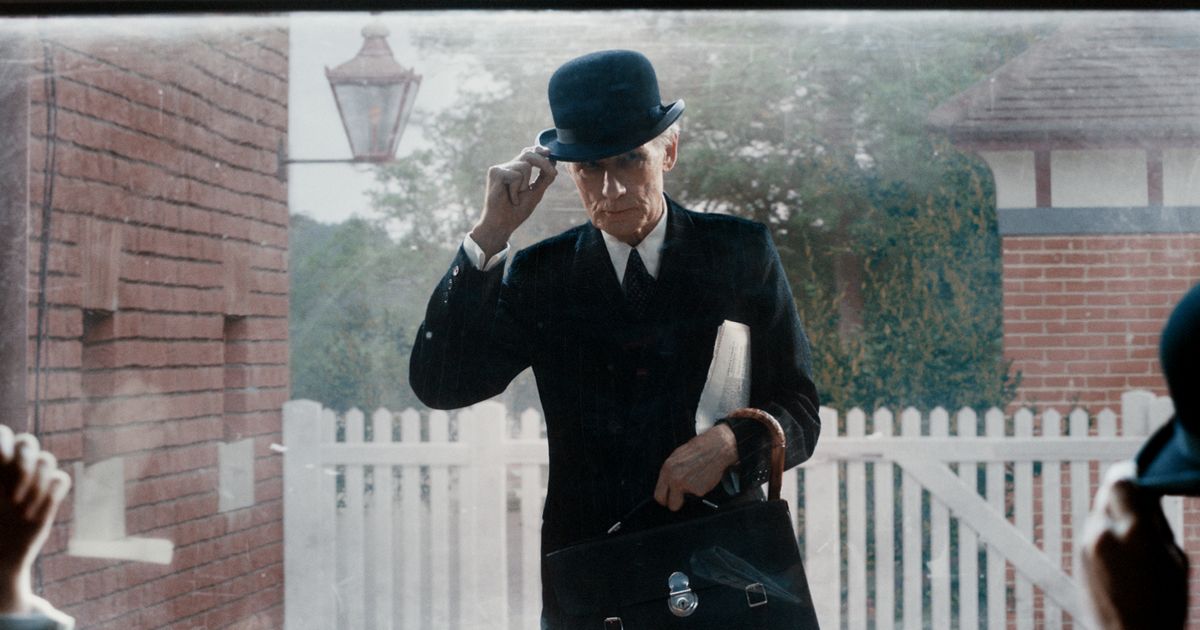
Living Communes with the Past to Honor a Kurosawa Classic
When it was properly released in the U.S. in 1960, eight years after it had opened in Japan, Akira Kurosawa’s Ikiru was sometimes marketed with the image of a half-naked dancer who appeared briefly in the film – quite a bait-and-switch for a somber, nearly two-and-a-half hour drama about an elderly Japanese bureaucrat dying of cancer. That infamous marketing campaign has gone down in history as a prime example of the flamboyant dishonesty of American film distributors in the 1950s and 60s. But it was also an understandable bit of chicanery. “Come watch an old man die!” wasn’t much of a tagline then, nor is it now.
Oliver Hermanus’s new drama Living, a rather faithful British remake of Ikiru set in 1950s London, has a similar challenge; we like to think we live in more sophisticated times, but we’re probably no more likely to go see such a seemingly morbid story any more than those earlier audiences were. So, it may come as a bit of a surprise when Living starts and we are immediately jolted by…color. Maybe not technically Technicolor, but something similarly saturated and rich. The film’s shimmering images, with their deep shadows and symmetric elegance, framed carefully in a classic Academy aspect ratio, create an effect reminiscent of something from the very period in which the movie is set. Living doesn’t try to reinvent or reimagine Ikiru so much as transport it, as if to speculate what Kurosawa’s masterpiece might have looked like had it been produced in the British film industry, in color, at around the same time.
In many of its details, the new movie, written by Nobel laureate Kazuo Ishiguro, adheres closely to the original. Our hero, Mr. Williams (Bill Nighy), is a stuffed-shirt functionary who, upon learning that he’s got only a few months left to live, struggles to find meaning and joy. Then he realizes that, as a lifelong civil servant who understands the levers of power in the paralyzing bureaucracy in which he works, he can make a difference by simply helping build a modest children’s playground in a neglected corner of the city.
It would be incorrect, however, to call Hermanus and Ishiguro’s approach a replication, or imitation. The music and the cutting, or for that matter the performances, aren’t in themselves what you’d find in a ‘50s film. This is not campy cosplay, but a kind of communion with the spirit and simplicity of the past. Because there’s something ingenious about the film’s style. Living traffics in relatively basic ideas. The repression and conformity of stuffy middle-class jobs, the need to look up from a life lived within the tight parameters of society and to seize the moment – these are rudimentary, even corny themes at this point, worked over in novels and films for decades. How, then, to revitalize them for today’s audience? Well, maybe by evoking the textures of a film made in the 1950s, to help bridge the cognitive gap. A more modern approach might seem impoverished, shallow, lacking in complexity. Now, cloaked in the trappings of a film from 70 years ago, it feels like a message relayed from a hazy past to our smug present.
Like Ikiru, Living locks us into the central character’s despair. Grief and mortality transform this shadow-figure into an avatar of the human condition; we know just enough about him to let our imaginations race, and not much more. Lanky and prim, the always-excellent Nighy portrays Williams with an aristocratic reserve. We slowly learn that for him, this veneer of calm and muted confidence is an existential ambition; he’s spent his life aspiring to be a gentleman. This actually stands in marked contrast to Ikiru’s Takashi Shimura, one of Japan’s greatest and most versatile actors, who brought to that film’s protagonist Watanabe a broad, almost theatrical anguish. Suffer in silence or rage at the snuffing of one’s light; either approach works. We all die in our own way.
Moving and engaging and visually splendid in equal measure, Living makes for a surprisingly pleasant cinematic journey, but Ikiru is a 142-minute machine designed to crush your heart into a million pieces. New Yorkers can actually see Kurosawa’s film in all its 35mm glory at the Metrograph starting next week; for everybody else, there’s Criterion or HBO Max. If you haven’t seen it yet, you really should. While its canonic status is secure, Ikiru is one Kurosawa classic that sometimes gets ignored because it’s not a crime picture or a Samurai epic. But it remains a marvelous showcase for the director’s humanity, and for his ability to strip his characters of their illusions and biases, layer by layer, until all that remains is something raw, real, and beautiful. (It should come as no surprise that the team that created this movie immediately went and made Seven Samurai.) When Watanabe, in Ikiru’s most indelible scene, finds himself all alone one night on a swing in the playground he made possible, it feels like we’re seeing this character in full for the first time, his upright past and his sorrowful present (for he has no future) collapsing into one devastating frame, an old man singing a song from his childhood to himself in the snow.
Both Ikiru and Living are set in the years following World War II, and while the war is mentioned briefly, one does wonder how much the destructive uncertainty of those years (not to mention the global depression that preceded them) played into Williams and Watanabe’s respective desires to put their heads down and work their uneventful jobs. Monotony and constancy gain their own kind of luster when the world is going mad. Yes, Kurosawa saw a stifling, repressive complacency in the workaday bureaucrats of post-war Japan, and there are passages of Ikiru where he skewers them mightily. But he also saw their humanity, their buried striving. The highest compliment I can pay Living is that it takes those dusty ideas and makes them resonate once more. Not unlike remembering an old, familiar song, and understanding it for the first time.








































![iFi's GO Bar Kensei Dongle DAC Supports K2HD Technology With Some Samurai Swagger [Updated] iFi's GO Bar Kensei Dongle DAC Supports K2HD Technology With Some Samurai Swagger [Updated]](https://i0.wp.com/cdn.ecoustics.com/db0/wblob/17BA35E873D594/33FF/45A11/QTXOLJR4xDKSNMMk2WlTgjaIlvSgcYpeU1xJzUwIoYs/ifi-go-bar-kensei.jpg?w=768&ssl=1)

































